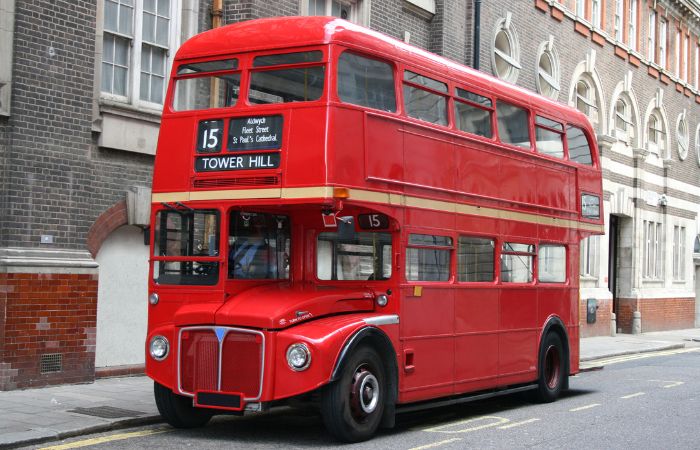The London bus, the iconic red Double-Decker is one of the symbols of the city. We know its history and the reasons why it is worth getting on board.
What are London’s most popular attractions? Big Ben, the Thames, Buckingham Palace, the red telephone booths, which are now kept only as an attraction for tourists, and many other things that make this city one of the most visited in the world.
Yet, seeing images of the UK capital, how often do we come across London‘s iconic red double-deckers?
The red double-decker bus is one of London’s most famous features, and with good reason. Just like the Metro, these buses are one of the fastest and most efficient ways to travel through the hustle and bustle of the ever-expanding European metropolis.
You may not know it, but the buses you see in London today are no longer the original ones. Behind the birth of these particular cars there is a beautiful story to tell, which starts from discovering how it all began.
For example, did you know that London buses are red because the General Omnibus Company that designed them in 1907 wanted to distinguish themselves from other transport companies? Here’s everything you need to know about the birth of London double-deckers and why they’re still so popular today.
The first known means of transport for people in London were born in 1829 and were drawn by horses. Their purpose was to get people from one destination to another, just like a taxi service.

Started by George Shillibeer, the primordial taxis carried people from Paddington to the city in a horse-drawn omnibus, intending to offer a similar service to today’s buses.
In 1855 an organization was formed, called the London General Omnibus Company, which managed all the horse-drawn vehicles in London at that time, with the aim of preventing misunderstandings and giving an efficient service to the population
The story of the London double -decker steam coach
1919 saw the rise of the first steam-powered buses which took the place of horse-drawn carriages, bringing a more modern option to the city, thanks to the technological advances of the time.
Even these cars, however, soon went out of use and were replaced by new motor buses, which were even more efficient.
The London General Omnibus Company at this same time became part of the London Passenger Transport Board and their division became known simply as London Transport.
It is at this point that double-deckers begin to take on their iconic red colour.
We have to wait until 1906 before buses began to be identified by numbers, to differentiate the routes they would take. In 1924 the authority to choose numbers for each bus was given to the Metropolitan Police, but this led to much confusion and organization problems for the transport companies.
Thus, in 1933, thanks to the London Transport Passenger Act this task was returned to the owners of the bus companies who made sure that everything was in order again. And so it has continued up to the present day.
In 2000, the management of London buses was transferred from the government-controlled London Regional Transport to Transport for London, or TFL, which is the London transport organization which continues to control city double-deckers to this day.
Why hop on a double-decker during your stay in London
There are four types of double-decker buses plying the streets of London today.
When visiting the city, you mainly see the boxy models of the late 20th century, the new elegant and rounded buses and of course the ubiquitous double-decker buses with no roofs, transformed into hop-on/hop-off tour buses. The fourth type, which has become rare by now, is the classic old Routemaster from the 1950s.

The century-old success of London’s iconic double-deckers lies in the fact that today they remain one of the most convenient, economical and enjoyable ways to get around the city.
Here are seven reasons why it’s worth taking at least one bus trip on your next London break.
It’s a cheap way to get around
Unless you decide to walk or cycle everywhere, the bus is definitely the best way to get around without breaking the bank. Despite the continuous increases in recent years, in London you can buy an unlimited day pass which costs just over 5 pounds.

Just remember that London buses do not accept cash, so you need to pick up an Oyster card at any tube station before you can travel.
Gives a better view of the city
When traveling on the subway, you go underground and then reappear somewhere else with no idea how point A connects to point B. It doesn’t help that the subway map is designed to be aesthetically pleasing, it’s still a route “in the dark”.
By taking the bus, however, you can find out how one area connects to another and where the main points to visit are on the map in relation to other areas.
The views are fantastic
The feature that makes double-decker buses so captivating is that the view from above is spectacular.

People who sit upstairs love to see the city go by from those seats up high. Plus, because the bus is taller than anything else you might encounter on the road, the views are never obstructed no matter how busy the traffic gets.
It’s the easiest way to get around with a stroller
For those traveling with children, it can be really difficult to maneuver a stroller through subway stations: very few have lifts, and it is rare to find a station that does not have at least some stairs.
On the bus, on the other hand, it is easy to get on without having to force the child to get off and load everything on his shoulder.
Furthermore, each vehicle has specially marked spaces where it is possible to park the stroller during the journey.
The paths are really direct
When traveling on the subway, it can also happen that you spend a lot of time underground moving from one line to another.

On the contrary, it is almost always possible to find a direct bus capable of taking anyone from where they are to where they want to go. Most of the time you hop on and off within a block or less of your final destination. Even with the traffic, it is often much faster to take the bus than the metro.
Google Maps makes it simple
The Google Maps app (but there are others as well) makes it extremely easy to see exactly where the nearest bus stop is and what numbers pass through there.
These apps will come in very handy when organizing trips to London while staying at Egham.
Furthermore, both from the apps and from the billboards posted at each stop, it is easy to find out how often the bus arrives, and which are all the stops that that route makes. Before the advent of smartphones, taking the bus could take more effort, but now it’s definitely much easier to get around.
They are usually not too crowded
Despite their efficiency, not many tourists take the bus, and as there are so many (most run every 3-10 minutes) with so many seats, they are generally not too crowded.
No matter the time of day, getting on a double-decker it is very easy to be able to make the journey comfortably seated.





